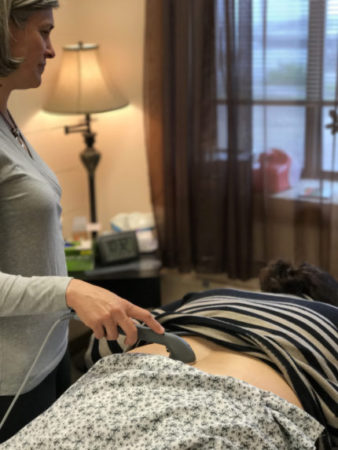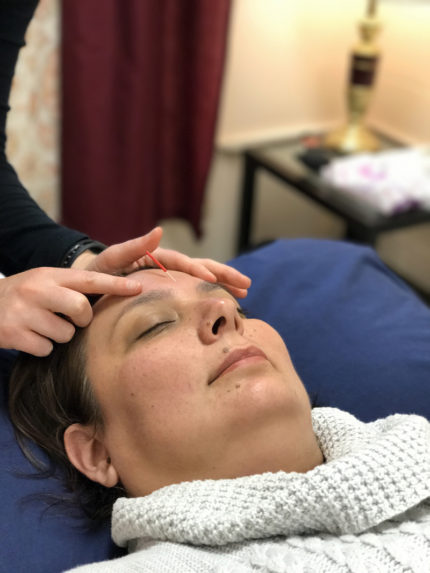Samantha (Sam) Bassett’s not sure how or even if she injured her lower back, but several years ago, it began to hurt. She saw the doctor and found out that she had two herniated discs — at L5 and S1. They are the lowest parts of the spine and bear the most weight, which means they’re most at risk of degenerating or being injured.

At the time, she was taking a gentle yoga class at Jade Integrated Health in Portland, Maine. “The only time I felt relief from pain was in yoga,” she told me. “We’d do legs up the wall with the bolster and Lauren, the instructor, was helping me do very gentle things to keep my body moving.”
She stayed under the care of her doctor and getting physical therapy, but only yoga seemed to ease her pain. She was also on 800 milligrams of Ibuprofen every day, which upset her stomach. A shot of cortisone directly into her spine hurt so much she was referred to a back specialist. “He said you need surgery, you need to have your cartilage removed and your bones fused,” Sam said. “I thought that sounded like a horrible idea. I just didn’t want to do it.”
- One-on-one yoga treatment
- Physical Therapy
One day in yoga class, Lauren suggested that she do physical therapy at Jade. That way, she and the physical therapist could work together to try and relieve her pain. Not only did their combined efforts work, Sam also learned a whole new way of moving.
“The way I sit,” she explained. “The way I get out of bed, the way I get into my car. All that needs to be done with intention if I’m not going to hurt my back again. They taught me how to move, how to bend. I bend differently now, I twist differently and I take the practice of yoga with me everywhere.
- Nancy Charlebois, PT, LMT
- John Charlebois, LAC
Nancy Charlebois is the head physical therapist at Jade. She’s also the owner, along with her husband John, who is an acupuncturist. They met at Springfield College in Springfield, Massachusetts, where they were both shaped by the school’s underlying philosophy of humanics or the balanced individual. On Springfield’s website, it states, “We believe, as did the ancient Greeks, that a person’s emotional, intellectual, and physical lives are interconnected.”
When they decided to open Jade Integrated Health 16 years ago, they knew that it would be a balanced, collaborative practice that addressed each person as a whole. John wouldn’t be doing acupuncture treatments in one corner while Nancy did physical therapy in another.
They tailor their treatment approach to the individual, often using a combination of therapies that may include physical therapy, one on one yoga sessions, acupuncture, dry needling, or massage. “We give clinicians the clinical latitude to pull in the modalities that they find the most appropriate for the patient,” said Nancy. It’s not a cookie-cutter approach.”
‘We have a unique approach,” said John, “which physicians really understand. They think it’s something worthwhile to recommend to their patients, whether it be something that is stress related or pain related or linked to a disease or pathology.”
Guidelines for treating low back pain
In February 2017, the American College of Physicians issued new guidelines for treating acute and subacute low back pain. John was quick to point out that they are right in line with what Jade was already offering.
Given that most patients with acute or subacute low back pain improve over time regardless of treatment, clinicians and patients should select nonpharmacologic treatment with superficial heat (moderate-quality evidence), massage, acupuncture, or spinal manipulation (low-quality evidence). If pharmacologic treatment is desired, clinicians and patients should select nonsteroidal anti-inflammatory drugs or skeletal muscle relaxants (moderate-quality evidence). (Grade: strong recommendation)
For patients with chronic low back pain, clinicians and patients should initially select nonpharmacologic treatment with exercise, multidisciplinary rehabilitation, acupuncture, mindfulness-based stress reduction (moderate-quality evidence), tai chi, yoga, motor control exercise, progressive relaxation, electromyography biofeedback, low-level laser therapy, operant therapy, cognitive behavioral therapy, or spinal manipulation (low-quality evidence). (Grade: strong recommendation)
A third recommendation is for people with chronic low back pain:
Recommendation 3:
In patients with chronic low back pain who have had an inadequate response to nonpharmacologic therapy, clinicians and patients should consider pharmacologic treatment with nonsteroidal anti-inflammatory drugs as first-line therapy, or tramadol or duloxetine as second-line therapy. Clinicians should only consider opioids as an option in patients who have failed the aforementioned treatments and only if the potential benefits outweigh the risks for individual patients and after a discussion of known risks and realistic benefits with patients. (Grade: weak recommendation, moderate-quality evidence)
Pain is not the only thing they treat at Jade. Women’s health is another area of focus, in general as well as prenatal and postpartum care. They also just opened a second office in Brunswick, Maine where they offer the same services they do in Portland.
Let’s get back to Sam for a minute. Working with Nancy (Physical Therapy) and Lauren (Yoga) did the trick — until she twisted her back and could hardly move. That’s when they called in the acupuncturist. “They said to come in right away and they put me on the table with John. I went from pain so bad I couldn’t move and I was holding my breath to at least being able to get up off the table and walk out.”
Right now Sam is in good shape. She continues doing yoga and when necessary, her team at Jade pulls together again.Surgery is always an option, but she hopes she’ll never need it.
By the way, an interesting fact about Sam is that she’s an air traffic controller. When she’s on duty, she has to sit and focus for an hour to an hour and a half at a stretch. And I imagine it can be a pretty stressful job. No wonder her back hurts sometimes. I’m glad she’s feeling better.






Leave A Comment